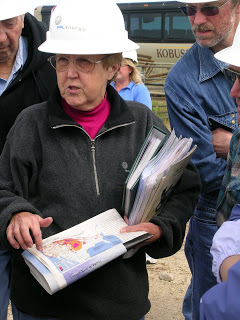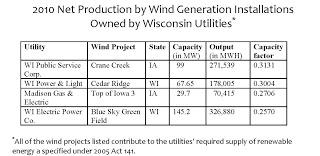by jboullion | Oct 26, 2011 | Uncategorized
From an article by Judy Newman in the Wisconsin State Journal:
Two reports show Wisconsin has a significant renewable power industry, but with a stronger state commitment, it could be saving more energy and creating more jobs.
Wisconsin has more than 300 businesses involved in wind or solar energy, providing more than 12,000 jobs, according to a study by the Environmental Law and Policy Center in Chicago.
It found 171 Wisconsin companies that either produce, sell or install wind power equipment or plan wind development.
Another 135 companies are part of the solar energy industry. For example, Cardinal Glass makes solar panels in Mazomanie; Helios recently opened a solar panel factory in Milwaukee.
“These are real jobs; these are real businesses. Many are existing businesses that are branching out into new product lines,” said Howard Learner, the center’s executive director.
Ten years ago, Wisconsin was considered a leader on renewal energy policy, so companies located here, Learner said. “That policy support has now been eroding, and neighboring states —Minnesota, Illinois and Michigan — now have much stronger renewable standards than Wisconsin does and are exceeding Wisconsin in terms of jobs,” he added.
Meanwhile, at a news conference Tuesday, representatives of clean energy businesses made a pitch for more money for Wisconsin’s Focus on Energy program, saying it will save energy, cut consumers’ costs and create jobs.
In the 10 years since it was created, Focus programs have saved utility customers 6.8 billion kilowatt-hours of electricity, or 6.8 months of the total residential power use in the state, says the report by the Midwest Energy Efficiency Alliance in Chicago. It says the programs also have saved 278 therms of natural gas, or 1.8 years of statewide residential consumption.
by jboullion | Oct 10, 2011 | Uncategorized
From an article by Clay Barbour in the LaCrosse Tribune:
Hundreds of jobs and millions of dollars in potential economic development are stuck in limbo as officials continue to argue over new wind siting rules.
The new rules, more than a year in the making, were suspended earlier this year just before they were to go into effect. A legislative committee sent them back to the Public Service Commission, which was tasked with finding a compromise between both sides.
Now, some seven months later, PSC officials say they are no closer to a deal than when they started. Meanwhile, wind farm developers such as Midwest Wind Energy and Redwind Consulting are sitting on their hands, and their money.
“Right now, we just don’t have a path forward in Wisconsin,”said Tim Polz, vice president of Midwest Wind Energy, a company that suspended work earlier this year on a large wind farm in Calumet County. “The uncertainty is just too much now.”
Polz said Chicago-based Midwest already spent three years and about $1 million on the Calumet County project. In full, the company expected to spend upward of $200 million on the project, employ 150 to 200 construction workers for up to 18 months and five to eight people full time after that. . . .
Walker said he is aware of the stress caused by the delay but feels it is important any rules be fair to both sides, respecting property rights and the future of the wind industry.
Meanwhile, state Sen. Frank Lasee, R-De Pere, plans to introduce a bill Monday to call for a moratorium on wind turbines until the PSC receives a report from the Department of Health Services on possible health effects of wind farms.
“It is more important to fully vet, understand and communicate to the public the potential changes than the specific timing of when they are adopted and enacted.” Walker said. “It is important to note that whatever proposed changes are made, there are effects on a number of different areas of the economy.”
by jboullion | Oct 5, 2011 | Uncategorized

by jboullion | Sep 28, 2011 | Uncategorized
News release
Renew Wisconsin
September 27,2011
More information:
Michael Vickerman
Executive Director
608.255.4044
mvickerman@renewwisconsin.org
The Montfort Wind Energy Center, a popular attraction in western Iowa County along U.S. Highway 18, turned 10 years old this summer. The 30-megawatt (MW) project, which for many years was Wisconsin’s largest commercial wind energy installation, began generating electricity in 2001, and thus far has produced over 500,000 megawatt-hours of electricity. In a typical year, Montfort’s output serves more than 5,000 households.
The project’s 20 turbines are divided into two arrays. The main array, consisting of 17 turbines, runs along the southern side of U.S. 18 between Cobb and Montfort. The output from those 17 turbines is sold to Milwaukee-based We Energies. The other three turbines, located to the south of the main array, produce electricity under contract to Alliant Energy’s Wisconsin Power & Light subsidiary, whose service territory covers Iowa County.
Originally developed by Enron Wind, the Montfort project was purchased in 2001 by NextEra Energy Resources, a Juno Beach, Florida-based company. Residents of Cobb and Montfort have been strongly supportive of this project. “Montfort has a gas station called Windmill Mobil,” said Carol Anderson, a project landowner. “Most commonly, I hear people ask ‘When we’re going to get more’?” Just east of the Windmill Mobil, an informational kiosk on the project stands prominently in front of the Tower Junction restaurant, located directly across the highway from Montfort’s westernmost turbines.
Carol Anderson holds a map of Wisconsin to show a group the topography with the best wind resource for projects similar to the Montfort Wind Farm.
“People are also surprised at how quiet the turbines are,” Anderson said. “Some family members still live in our homestead only 2,000 feet from the turbines, and they don’t have any problems with noise or anything else.
This project has brought economic development to Iowa County,” Anderson said. “Conservation is a big value in this area. All of us appreciate the conservation aspects of the clean energy.” Montfort is not the first Wisconsin wind project to complete 10 years of continuous operation. Others include the Rosiere and Lincoln projects in Kewaunee County, totaling 31 turbines, and the two-turbine Byron project south of Fond du Lac along U.S. Highway 41.
“Wind generation is proving to be a reliable source of clean energy over the long haul,” said Michael Vickerman, executive director of RENEW Wisconsin, a statewide organization promoting Wisconsin’s renewable energy marketplace. “Furthermore, unlike coal-fired generators, wind projects will never need expensive retrofits to comply with federal clean air regulations because they don’t produce particulates, sulfur compounds or greenhouse gases.”
“Wisconsin utilities are now in the process of spending more than a billion dollars to clean up their older coal-fired power stations,” Vickerman said. “This is a considerable expense that utility ratepayers will fully absorb. By contrast, Montfort’s owner will never have to spend a dime on pollution control technology over its entire operating life.”
“When you add the cost of retrofitting older coal-fired units to the cost of supplying these generators with fuel transported from Wyoming, windpower is hands down the better economic choice,” Vickerman said.
In addition to Montfort, NextEra Energy Resources also owns and operates the 36-turbine, 54 MW Butler Ridge project near Iron Ridge in Dodge County. That project started commercial operations in 2009.

by jboullion | Aug 25, 2011 | Uncategorized
Immediate release
August 25, 2011
More information
Michael Vickerman
Executive Director
608.255.4044
mvickerman@renewwisconsin.org
Wind Farm Productivity Comparable to Iowa’s
Production figures from wind energy projects owned by Wisconsin utilities reveal that there is no significant difference between wind farms in Iowa and the Badger State, according to an analysis of utility annual reports performed by RENEW Wisconsin, a statewide organization advocating for public policies and private initiatives that advance renewable energy.
The most productive wind project last year was Wisconsin Public Service’s Crane Creek project in Howard County, Iowa, followed closely by Wisconsin Power and Light’s Cedar Ridge project in Fond du Lac County. (See table below.) The output from both projects in 2010 exceeded 30 percent of their rated capacity. Capacity factor is a measure of actual output relative to potential output if the turbine ran 100 percent of the time at full capacity.
“These figures suggest that the winds in Wisconsin can deliver significant quantities of clean energy to nearby users,” said Michael Vickerman, executive director of RENEW. “This is especially true of the newer turbines with taller towers and longer blades.”
“Clearly Wisconsin ratepayers are getting their money’s worth from Wisconsin’s newest wind projects,” Vickerman said. “Moreover, the host communities reap considerable economic benefits in the form of payments to local governments and landowners.”
Differences in output between wind projects in the same region can be attributable to causes other than the wind resource itself. These can include shutdowns caused by grid congestion and operating restrictions aimed at minimizing impacts on wildlife and project neighbors.
“The evidence suggests that Cedar Ridge is a standout performer among Wisconsin wind projects, and every bit as productive as the projects in Iowa owned by Wisconsin utilities,” said Vickerman.
Click table to enlarge.


